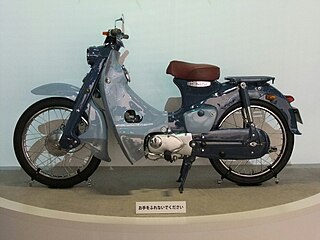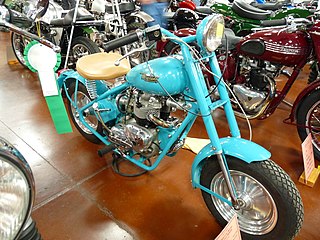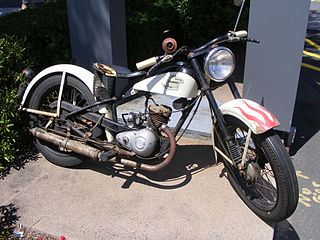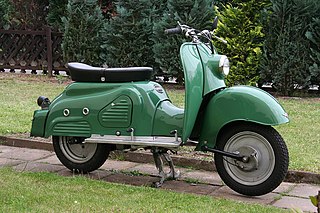The Loudon Classic, originally named the Laconia Classic, is an annual motorcycle road racing competition held during the Laconia Motorcycle Week at the New Hampshire Motor Speedway in Loudon, New Hampshire. Founded in 1934 when it was originally sanctioned by the American Motorcyclist Association (AMA), the race is one of the oldest motorcycle competitions in the United States. The competition changed locations over the years, starting as a dirt track race before evolving into a road race. From the late 1930s until the early 2000s, the Loudon Classic was one of the most prestigious motorcycle races in the United States, second only to the Daytona 200.

A flat-twin engine is a two-cylinder internal combustion engine with the cylinders on opposite sides of the crankshaft. The most common type of flat-twin engine is the boxer-twin engine, where both pistons move inwards and outwards at the same time.

A custom motorcycle is a motorcycle with stylistic and/or structural changes to the 'standard' mass-produced machine offered by major manufacturers. Custom motorcycles might be unique, or built in limited quantities. While individual motorcyclists have altered the appearance of their machines since the first days of motorcycling, the first individualized motorcycles specifically labeled 'Custom' appeared in the late 1950s, around the same time as the term was applied to custom cars.

A sports motorcycle, sports bike, or sport bike is a motorcycle designed and optimized for speed, acceleration, braking, and cornering on asphalt concrete race tracks and roads. They are mainly designed for performance at the expense of comfort, fuel economy, safety, noise reduction and storage in comparison with other motorcycles.

The Honda Super Cub is a Honda underbone motorcycle with a four-stroke single-cylinder engine ranging in displacement from 49 to 124 cc.

A motorcycle engine is an engine that powers a motorcycle. Motorcycle engines are typically two-stroke or four-stroke internal combustion engines, but other engine types, such as Wankels and electric motors, have been used.

In the market, there is a wide variety of types of motorcycles, each with unique characteristics and features. Models vary according to the specific needs of each user, such as standard, cruiser, touring, sports, off-road, dual-purpose, scooters, etc. Often, some types like sport touring are considered as an additional category or integrated with touring.

The Ner-A-Car was a type of feet forwards motorcycle designed by Carl Neracher in 1918. It used an unusual steel-channel chassis, much like an automobile, and hub-center steering at the front wheel, making it 'nearly a car' in design. The Ner-A-Car was the most successful hub-center steering motorcycle ever produced, with sales far eclipsing earlier or later examples of this design, such as the Yamaha GTS1000 or Bimota Tesi. About 10,000 Neracars were manufactured in the United States by the Ner-A-Car Corporation, while around 6,500 are believed to have been produced in England under licence by the Sheffield-Simplex company between 1921 and 1926 under the Ner-A-Car name.

The Mustang was a lightweight motorcycle built by Gladden Products Corporation in Glendale, California, from 1946 to 1965. The second production version, the Mustang Model 2, was among the first motorcycle manufactured in the United States to have a telescopic fork.

The Harley-Davidson XA was a flat-twin, shaft drive motorcycle made by Harley-Davidson for the US Army during World War II.

The Hummer was a motorcycle model manufactured by Harley-Davidson from 1955 to 1959. However, the name "Hummer" is now incorrectly used generically to refer to all American-made single-cylinder two-stroke Harley-Davidson motorcycles manufactured from 1948 to 1966. These motorcycles were based on the DKW RT125, the drawings for which were taken from Germany as war reparations after World War II. The RT125 drawings were also given to the United Kingdom and the Soviet Union as war reparations, resulting in the BSA Bantam and the MMZ M-1A Moskva, later known as the Minsk.

Berliner Motor Corporation was the US distributor from the 1950s through the 1980s for several European motorcycle marques, including Ducati, J-Be, Matchless, Moto Guzzi, Norton, Sachs and Zündapp, as well as selling Metzeler tires. Berliner Motor was highly influential as the voice of the huge American market to the motorcycle companies they bought bikes from, and their suggestions, and sometimes forceful demands, guided many decisions in Europe as to which bikes to develop, produce, or discontinue.
Joe Berliner [...] a man endowed with great decision-making power in Borgo Panigale

A scooter is a motorcycle with an underbone or step-through frame, a seat, a transmission that shifts without the operator having to operate a clutch lever, a platform for their feet, and with a method of operation that emphasizes comfort and fuel economy. Elements of scooter design were present in some of the earliest motorcycles, and motor scooters have been made since at least 1914. More recently, scooters have evolved to include scooters exceeding 250cc classified as Maxi-scooters.

Charles Bayly Franklin was an engineer and a motorcycle racer. He designed motorcycles for the Indian Motocycle Company, including the original Indian Scout of 1920, the original Indian Chief of 1922, and the Indian 101 Scout of 1928. Prior to this, he had been part of the Indian motorcycle team that won first, second, and third place in the 1911 Isle of Man TT, finishing in second place. Franklin was inducted into the AMA Motorcycle Hall of Fame in 2016.

Simplex Manufacturing Corporation was an American manufacturer that made motorcycles from 1935 to 1975. Between 1935 and 1960, Simplex made variations of the Simplex Servi-Cycle including the 1953–1960 Simplex Automatic. Simplex was the only motorcycle manufacturer located in the Deep South for many years, until Confederate Motorcycles began production.

The following outline is provided as an overview of motorcycles and motorcycling:

The Daimler Reitwagen or Einspur was a motor vehicle made by Gottlieb Daimler and Wilhelm Maybach in 1885. It is widely recognized as the first motorcycle. Daimler is often called "the father of the motorcycle" for this invention. Even when the steam powered two-wheelers that preceded the Reitwagen, the Michaux-Perreaux and Roper of 1867–1869, and the 1884 Copeland, are considered motorcycles, it remains nonetheless the first gasoline internal combustion motorcycle, and the forerunner of all vehicles, land, sea and air, that use its overwhelmingly popular engine type.

Lambretta is a brand of motor scooters, manufactured in Milan, Italy, by Innocenti.

The Cleveland Motorcycle Manufacturing Company, sometimes called Cleveland Motorcycle, was a motorcycle manufacturer in Cleveland, Ohio, from 1902 to 1905 and again from 1915 to 1929.

The Zündapp Bella is a motor scooter manufactured by German motorcycle manufacturer Zündapp from 1953 to 1964. Approximately 130,000 Bella scooters were sold, with engine sizes ranging from 150 to 200 cc.



















